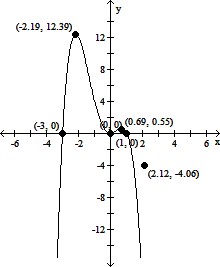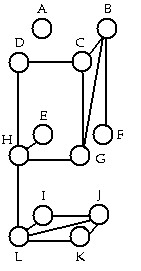Analyze the graph of the given function f as follows:(a) Determine the end behavior: find the power function that the graph of f resembles for large values of |x|.(b) Find the x- and y-intercepts of the graph.(c) Determine whether the graph crosses or touches the x-axis at each x-intercept.(d) Graph f using a graphing utility.(e) Use the graph to determine the local maxima and local minima, if any exist. Round turning points to two decimal places.(f) Use the information obtained in (a) - (e) to draw a complete graph of f by hand. Label all intercepts and turning points.(g) Find the domain of f. Use the graph to find the range of f.(h) Use the graph to determine where f is increasing and where f is decreasing.f(x) = -x2(x - 1)(x + 3)
What will be an ideal response?
(a) For large values of |x|, the graph of f(x) will resemble the graph of y = -x4.
(b) y-intercept: (0, 0), x-intercepts: (-3, 0), (0, 0), and (1, 0)
(c) The graph of f crosses the x-axis at (1, 0) and (-3, 0) and touches the x-axis at (0, 0).
(e) Local maxima at (-2.19, 12.39) and (0.69, 0.55); Local minimum at (0, 0)
(f) 
(g) Domain of f: all real numbers; range of f: (-?, 12.39]
(h) f is increasing on (-?, -2.19) and (0, 0.69); f is decreasing on (-2.19, 0) and (0.69, ?)
You might also like to view...
The population N, in thousands, of a small town after t years is given in the following table. Use exponential regression to determine the population after 19.15 years. Round your answer to two decimal places. t 1.35 4.61 8.53 11.67 15.15 N 22.22 12.44 6.83 3.66 2.13?
A. 2.54 thousand B. 1.49 thousand C. 4.25 thousand D. 0.99 thousand
Determine whether the sequence of vertices is i) a walk, ii) a path, iii) a circuit in the given graph. I ? L ? K ? J ? I
I ? L ? K ? J ? I
A. Walk only B. Walk, path, and circuit C. Walk and path D. None of these
Insert the symbol < or > between the pair of numbers.-9  -1
-1
A. > B. <
Find the volume of the sphere satisfying the given condition. Approximate values to the nearest tenth.radius = 0.95 cm
A. 2.0 cm3 B. 28.7 cm3 C. 3.6 cm3 D. 3.8 cm3